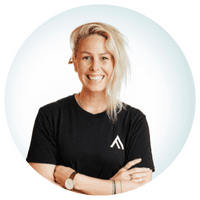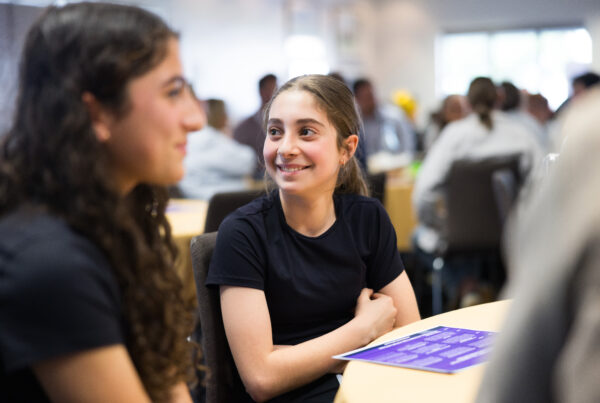
On Goldilocks, cold coffee and starting at the end of the learning journey.
by Nicole Dyson, Founder & CEO, Future Anything
Let me tell you a story.
Everyone knows the tale of Goldilocks and the Three Bears.
Goldilocks goes gallivanting about a forest solo and, upon stumbling upon someone’s humble abode, wanders in and helps herself to a snack and a nap.
I thought I might rework this fable for a different context; today’s teacher…
Once upon a time, there was a passionate educator named Goldilocks.

Waking to her alarm, she haphazardly dressed and bleary-eyed, picked up a coffee (extra shot) on the way to work.
Arriving at school, she wandered through the school gates and, after asking two students to stop making out by the stairwell, pushed on the door to the staffroom and walked right in.
At her desk, in the center of the room, was a series of draft task sheets awaiting feedback.
Goldilocks was hungry. It was Week 10 and in her rush to leave the house, she sacrificed breakfast for the coffee stop.
Coffee is food, right?
Taking a sip from the now lukewarm coffee, she picked up the first assessment task from the pile and started reading.
In groups, students were to research a type of renewable energy. From there, they were to create a version of this type of power within Minecraft, as well as a home that makes use of this power.
“This task is too hot!” she exclaimed.
There was no way we would have enough devices for the students to access Minecraft for the required number of lessons needed to do the task justice.
Plus, the Minecraft Education PD wasn’t scheduled until the end of the next term. Many of the staff hadn’t used the program before, and whilst they were excited about the challenge, she knew there was a degree of apprehension amongst the team about learning another new thing.
Confident educators beget compelling curriculum. The whole team wasn’t confident. Yet.
So, she made the Minecraft unit optional for this year and started scoping an alternative task for those who wanted some more space and support.
Scouring the files on the G Drive, she found the ghosts of assessment past.
Blowing metaphorical dust off the files, she saw that last year’s introduction to renewable energy exam had sixty knowledge questions in 70 minutes.
“This task is too cold,” she says.

Where is the real-world connection?
Pulling the exam apart, she lined the content up with the weekly objectives in the Unit Overview and turned the summative pressure cooker into six ten-question quizzes.
Digitizing them using Microsoft Forms (or Quizziz), Goldilocks made it possible for students to ‘do-over’ the quizzes if they struggled in any of these weekly check-points; transforming the tasks into assessments for learning.
Sipping on her coffee, Goldilocks realised that this still didn’t solve the problem of what to use as a summative assessment task for those educators not yet comfortable diving into the world of Minecraft.
Going back to the beginning, Goldilocks started writing down the key learning objectives for the unit.
What do students need to be able to know by the end of this unit, and what should they be able to do?
With these in mind, Goldilocks then looked for an opportunity to personalise the learning; making the context relevant and real-world for each student.
What if students were to take a week to conduct a home inventory of their family’s energy consumption and then graph their individual family data on line plots?
After measuring the current use of resources in their home, students could then set goals for reducing resources and identify strategies to help their families achieve these goals before presenting their findings and recommendations back to the class.
Even better, why don’t we invite caregivers to attend the presentation so they can hear the recommendations firsthand?
It sounded good in theory, but if the task is being issued in Week 7, and the final was due in Week 9…
How in the world were students supposed to complete their investigation of energy use within their home, draft their report and consider recommendations, receive (and meaningfully apply) feedback, and submit; all whilst juggling the five other tasks due in the same week?
Actually, Goldilocks mused, how in the world was any educator going to turn around (quality) feedback for their students? Even if they used tools such as Screen-Cast-O-Matic to expedite the process and record feedback for each student, it seemed very Mission Impossible.
Shaking her head, “This task is just too big.”
Getting it just right.
Grabbing a piece of paper, Goldilocks started writing down, in chronological order, each of the steps that students would need to take in order to complete the task.
Next to each step, Goldilocks estimated how much class time it might take the teacher to set the average student up for success.
In a third and final column, Goldilocks estimated how long it might take the average student to complete the step.
Then she doubled each assumption to account for her own bias- and the diverse needs of the students in her class.
Adding up the numbers and mapping this against the due dates on the task sheet, Goldilocks muttered, “This is impossible.”
Recognising the inevitable fate of every well-planned term, Goldilocks knew she wasn’t going to be able to magic herself more of the one resource teachers didn’t have enough of; time.
She knew that running the unit as it stood would sink her, and her students.
So, she charted a new course.
“Let’s issue the task a week earlier in Week 6. Students can then complete the audit, and draft their recommendations. That then gives teachers a week of conferencing and providing feedback before students submit in Week 9.”
“Ahhh, this task is just right,” she said happily as she took another sip of her now iced coffee.
Happily ever after. For everyone.
It’s not just Goldilocks’ coffee going cold that might feel familiar to today’s teacher.
As we strive to build a generation of young people who are enterprising in the way that they approach learning and life, we’re using our Future Anything Enterprising Classrooms Framework to drive the change we want to see in our curriculum.
The convergence of design thinking, entrepreneurial pedagogy, inquiry- and project-based learning, the beginning of this framework starts at the end with the ‘Aspiration’ phase.
Taken from the Latin nominative aspiratio, Aspiration means imagining an inspiring end worth striving for.
We must ask ourselves, “Where are we going?” and “Why does it matter?”
Like a captain steering a ship, we can’t map the course or prepare our crew for the length and challenge of the journey if we don’t know exactly where we’re going.
The best destinations, or assessments, have three things in common:
- They’re realistic in expectation- both in time and for the age and stage of the student.
- They’re interesting for the student (and, importantly, the teacher).
- They’re connected to the real world.
Not too hot, not too cold.
Not too big, not too small.
Not too hard, not too soft.
Realistic, interesting, and connected.
Just right.
For our learners, and for us as teachers.
Future Anything offers a portfolio of student workshops, teacher professional development and in-curriculum project-based learning experiences that are building enterprising classrooms in Australia and beyond.
Find out more about our programs here.
Subscribe to Future Anything’s regular e-newsletter to have resources delivered right to your inbox. You can sign up here.
About the author: Nicole Dyson
As a teacher in the USA, UK and Australia as well as a Head of Department and Head of Year at some of Queensland’s top-performing public schools, Nicole has repeatedly led the design and implementation of whole-school changes to support future ready learning; building enterprising classrooms that place young people at the forefront of co-designing contextually relevant learning experiences.

Nicole is an engaging and skilled facilitator, panellist and speaker who is a passionate advocate for equity, the future of education, and empowering young people to bend the future; one youth-led idea at a time.
Connect with Nic on LinkedIn here or Twitter here.





